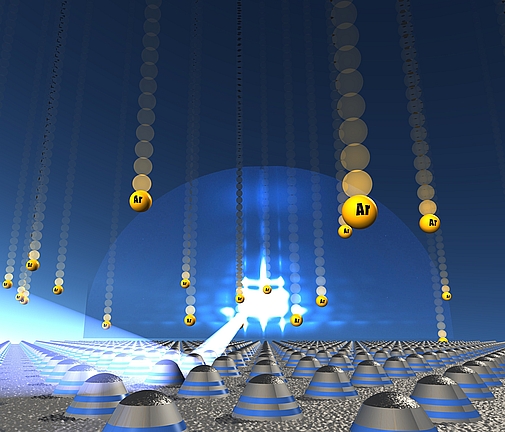Introduction
Small angle x-ray scattering under grazing incident angles (GISAXS) is a scientific method for analyzing nanoscaled surface structures and structures in thin films. It is useful as fast technique under difficult sample conditions and as a complementary method to direct imaging techniques. Direct microscopy techniques are often used to characterize the surface morphology and the lateral spacings of surface structures. The limitations of this methods are the very small observable area and the inability to determine buried and inner structures. Further limitations are the need of vacuum and electrical conductivity for electron microscopy and the limited scanning speed when AFM is used. Here, GISAXS overcome such difficulties as it can be performed at ambient conditions and each scattering pattern takes only a few seconds to record (depending of scattering contrast and beam intensity). These properties make GISAXS so interesting for the investigation of dynamic structure changes in physical and chemical processes at surfaces and in films.
![]() In-Situ GISAXS of Block Copolymer Templated Formation of Magnetic Nanodot Arrays - Nano Research 2017
In-Situ GISAXS of Block Copolymer Templated Formation of Magnetic Nanodot Arrays - Nano Research 2017
![]() (click image for further information at publishers online library)
(click image for further information at publishers online library)
In the last years the number of GISAXS investigations increased owing to the ability to perform such experiments at many experimental stations at synchrotron radiation sources. Also, with the ongoing development of strong radiation lab-sources, GISAXS is now available in smaller setups in many laboratories. These smaller setups have lower resolution and recording speed, but in many cases they show a sufficient performance for a given challenge. The method is now well established and the angular resolution of the scattering experiments is improved by using smaller beam sizes with low divergence. As with all x-ray scattering techniques, one is able to get information of electron density fluctuations of the illuminated area of the sample by monochromatic x-ray radiation. The applied radiation energy is most frequently in the range of 5 keV to 20 keV, due to good scattering to absorption ratio. For soft matter samples, the optimal energy is around 8 keV while for heavier elements a higher energy is recommended.
For the investigation of coatings, films and particles on surfaces, GISAXS has several important advantages over transmission scattering techniques. A highly intense scattering pattern is always obtained, even for films of nanoscale thickness, because the x-ray beam path length through the film plane is sufficiently long. Detectable length scales from a few to hundreds of nanometers are not limited by a beamstop which covers the information near q
